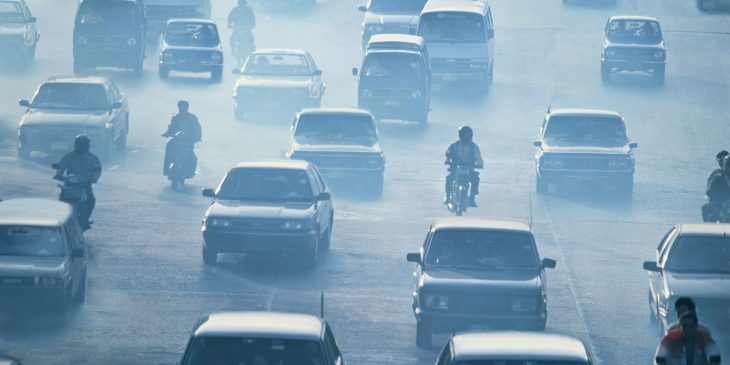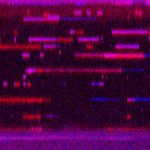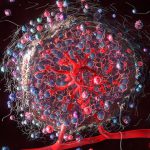Adults with asthma residing in impoverished and more racially diverse geographic areas within Allegheny County may be susceptible to increased asthma severity or less likely to have their symptoms under control, or both, according to recent research conducted by scientists at the University of Pittsburgh School of Public Health.
The study, published in The Journal of Allergy and Clinical Immunology and led by Dr. Brandy Byrwa-Hill while she was a Ph.D. student at Pitt Public Health, examined the relationship of traffic-related air pollutants (TRAP) with asthma severity and control in neighborhoods designated as Environmental Justice (EJ) tracts. EJ tracts have a population that is at least 30% non-white or 20% impoverished, or both, placing them at a heightened risk for disproportionate exposure to various pollutants, which is considered by the U.S. Environmental Protection Agency as an environmental injustice.
“We have known for some time that economically disadvantaged communities and communities composed of racial minorities often bear the burden of environmental pollution exposures throughout the U.S. – it was first noticed with toxic waste facilities, as a vast majority were in communities of color,” said co-author Dr. James Fabisiak, associate professor of environmental and occupational health and director of the Center for Healthy Environments and Communities at Pitt Public Health. “But for many diseases, including asthma, the relationship between disease duration, age of onset and pollution was unknown.”
The study showed that residing in an EJ tract was linked to heightened asthma severity in those who became symptomatic in adulthood, but did not affect the severity of those who developed the disease during childhood. Asthma controllability, on the other hand, was linked to disease duration: The longer an individual suffers from asthma while residing in an EJ tract, the more challenging it will be for them to control their symptoms over time.
“Not all asthma is created equal,” said Fabisiak. Asthma is a heterogenous disease, and its causes and triggers vary from person-to-person. The scientists suspect that adult-onset asthma may be particularly susceptible to prolonged exposure to air pollution, which is why they were seeing more exacerbations in people living in the EJ tracts.
The study involved adult asthma patients who lived in Allegheny County between 2007 and 2020 and were enrolled in the Asthma Institute Registry at the University of Pittsburgh Asthma and Environmental Lung Health Institute at UPMC. The patients’ EJ status was determined based on their address, and the individuals underwent spirometry testing to assess their lung function. Patients’ asthma onset, severity and controllability were determined based on a questionnaire given by the clinician.
“We wanted to see if living in an EJ tract had a relationship to the severity and controllability of asthma,” said Dr. Sally Wenzel, chair and professor at the University of Pittsburgh School of Public Health’s Department of Environmental and Occupational Health and director of the University of Pittsburgh Asthma and Environmental Lung Health Institute (AELHI) at UPMC. “If there was a relationship, we wanted to figure out if it was related to pollutants.”
Many factors can underlie asthma exacerbations, so the researchers specifically related measurements of TRAP – composed of nitrogen dioxide and black carbon, which is the soot emitted by vehicles, power plants and other industries that burn fossil fuel– to levels found in EJ tracts. To further untangle their influence on asthma severity and controllability, scientists then looked at factors not related to pollution that can influence asthma, such as EJ residents’ gender, weight, age, and marital and smoking status. Even after accounting for those factors, air pollution still explained some of the increased asthma severity and uncontrollability in EJ neighborhoods.
“The results of this study are directed at policymakers, clinicians and government officials,” said Wenzel. “If we can potentially enlighten these officials, let them know that people are at risk by living in an EJ tract, perhaps there will be more support for improving environmental conditions in these areas through policy directives.”
Fabisiak said that officials could make these environmental improvements by taking steps to require that EJ tracts are first in line for opportunities to swap TRAP contributors with more eco-friendly alternatives. For example, if electric buses are introduced to a city in phases, priority should be given to EJ neighborhoods.
Future research studies plan to expand the asthma registry to reach areas outside of urban Pittsburgh and explore the impact of different pollutants on asthma outcomes in more rural communities outside of Allegheny County. Pitt Public Health/AELHI plans to add studies to investigate chemical and biological biomarkers in people with asthma to examine if there are any measurable changes within the human body that can be attributed to residing in an EJ tract and TRAP exposure.









